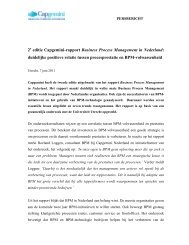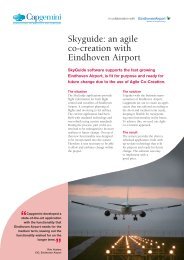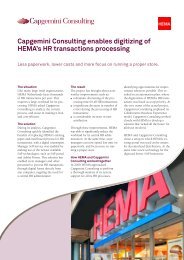IT transformations - Capgemini Consulting Nederland
IT transformations - Capgemini Consulting Nederland
IT transformations - Capgemini Consulting Nederland
You also want an ePaper? Increase the reach of your titles
YUMPU automatically turns print PDFs into web optimized ePapers that Google loves.
Redefine roles and responsibilities<br />
With new expectations and a new<br />
vision proposed, companies can<br />
redefine roles, or “who does what”.<br />
This means looking, not only at what<br />
they themselves need, but also what<br />
other players need. Companies need<br />
to take a strategic approach when<br />
it comes to choosing where they<br />
participate and what roles to play in<br />
the industry architecture. They need<br />
to be frugal with capital commitment<br />
and get the maximum amount of<br />
power to flow to them, even at the<br />
expense of some short-term benefits.<br />
Figure 2: Toolkit for Building Architectural Advantage<br />
1 2 3<br />
Identify<br />
Bottlenecks<br />
■ The bottleneck is the least<br />
replaceable part of the value<br />
chain or industry architecture<br />
Create Architectural<br />
Advantages<br />
■ Create a map of current industry<br />
architecture, customers, and<br />
products<br />
■ Locate the bottleneck<br />
■ Identify how the industry<br />
architecture could change<br />
■ Identify the impact of change in<br />
industry architecture<br />
■ Identify how to change current<br />
role and become the bottleneck<br />
Change Organization’s<br />
Fabric<br />
Encourage employees to:<br />
■ Have a vision of the company’s<br />
role in the sector<br />
■ Be ready to change vision<br />
■ Recognize that positions don’t<br />
last forever<br />
■ Have the courage to change<br />
routines<br />
■ Be outward looking<br />
■ Articulate vision outside the<br />
organization<br />
■ Be strategic, not just nice<br />
■ Keep larger picture in mind<br />
The final element in Apple’s iPod<br />
success is its dominance of the multibillion<br />
accessories market, where it<br />
has encouraged others to prosper but<br />
has not entered itself. Its restraint is<br />
calculated 7 . Even more calculated is<br />
its control of downstream pricing:<br />
Apple only gives 14% margin for<br />
iPods, while the margin on iPod<br />
accessories is 25%, so retailers<br />
dedicate more shelf space to them.<br />
This increases iPod presence in<br />
terms of retail and enhances the<br />
installed iPod accessory base (and<br />
dependencies on Apple), even though<br />
Apple is absent from the accessory<br />
segment. By finding intelligent<br />
ways of convincing retailers and<br />
business partners to invest in the<br />
iPod architecture, Apple ensures<br />
that the pie is large enough, and<br />
its allies strong enough, to beat the<br />
competition in unison. This contrasts<br />
with Apple’s mistakes in the PC<br />
sector, where its insularity shunned<br />
collaboration and it focused too much<br />
on “the traditional PC sector”.<br />
Choosing where to focus should not<br />
just concern a company’s strengths,<br />
or opportunities to make money; it<br />
should also be about how the firm<br />
can best support its position within<br />
the industry architecture: how its<br />
choices will shape the sector and help<br />
it become a bottleneck.<br />
Source: Professor Michael G. Jacobides<br />
A toolkit for building architectural<br />
advantage<br />
Architectural advantage can be<br />
built through a three-step process<br />
of identifying bottlenecks, creating<br />
architectural advantages through<br />
bottlenecks, and finally making<br />
architectural thinking a part of the<br />
organization’s fabric (see Figure 2).<br />
Identify bottlenecks<br />
Bottlenecks are a key part of industry<br />
dynamics. But where do they sit<br />
in the value chain? The bottleneck<br />
is the least replaceable part of the<br />
value chain or industry architecture,<br />
where value accrues. The greater<br />
the mobility of adjacent segments,<br />
the more effective the bottleneck<br />
becomes. Mobility and dependencies<br />
change over time, as does the position<br />
of the bottleneck (see Figure 3).<br />
“<br />
The most<br />
successful<br />
companies<br />
become the<br />
“bottleneck” in<br />
their sectors and<br />
“rule without<br />
owning”<br />
”<br />
7 The Australian, Gecko Gear Makes the Case for Quality iPhone Accessories, October 2010.<br />
87
















